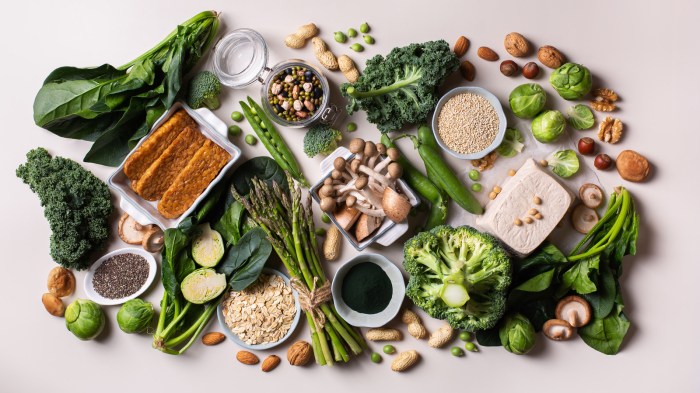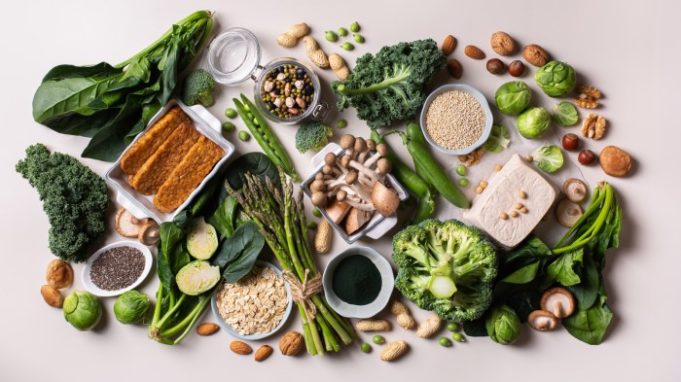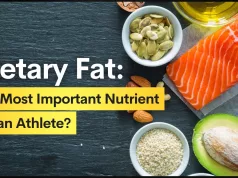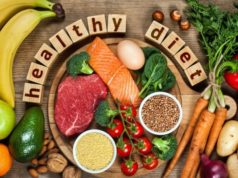How to start a vegetarian diet can seem daunting, but it’s a journey filled with delicious possibilities. From understanding the different types of vegetarianism to planning balanced meals, this guide provides a comprehensive roadmap for embarking on a plant-based lifestyle. Whether you’re motivated by ethical concerns, health benefits, or environmental impact, you’ll discover the joys of vegetarian living and the abundance of delicious, nutritious options available.
Embracing a vegetarian diet is more than just eliminating meat; it’s a mindful approach to eating that prioritizes whole foods, vibrant flavors, and sustainable choices. You’ll learn how to incorporate protein-rich legumes, tofu, and tempeh into your meals, explore the world of colorful vegetables and grains, and discover creative ways to satisfy your cravings while nourishing your body.
Understanding Vegetarianism
Vegetarianism is a dietary choice that involves abstaining from consuming animal products, with varying degrees of restriction depending on the specific type of vegetarianism. Understanding the different types of vegetarian diets and the motivations behind this choice is crucial for anyone considering adopting a vegetarian lifestyle.
Types of Vegetarian Diets
There are several types of vegetarian diets, each with its own set of restrictions:
- Lacto-ovo vegetarian: This is the most common type of vegetarianism, where individuals abstain from consuming meat, poultry, and fish, but include dairy products (milk, cheese, yogurt) and eggs in their diet.
- Lacto vegetarian: This type of vegetarianism excludes meat, poultry, fish, and eggs, but allows the consumption of dairy products.
- Ovo vegetarian: This type of vegetarianism excludes meat, poultry, fish, and dairy products, but allows the consumption of eggs.
- Vegan: This is the most restrictive type of vegetarianism, where individuals abstain from consuming all animal products, including meat, poultry, fish, eggs, dairy products, and honey. Vegans also avoid using products derived from animals, such as leather, wool, and silk.
Motivations for Vegetarianism
There are numerous reasons why individuals choose to adopt a vegetarian diet:
- Ethical concerns: Many vegetarians believe that it is ethically wrong to consume animal products, as they see animals as sentient beings deserving of respect and compassion. They may oppose factory farming practices, which are often criticized for their cruelty and inhumane treatment of animals.
- Health benefits: Vegetarian diets are often associated with lower risks of developing chronic diseases such as heart disease, type 2 diabetes, and some types of cancer. Plant-based foods are typically rich in fiber, vitamins, and minerals, which can contribute to overall health and well-being.
- Environmental impact: Animal agriculture is a major contributor to greenhouse gas emissions, deforestation, and water pollution. By reducing or eliminating their consumption of animal products, vegetarians can help to lessen their environmental footprint.
Famous Vegetarians and Their Stories, How to start a vegetarian diet
Many prominent individuals throughout history have been vegetarians, including:
- Leonardo da Vinci: The renowned artist and inventor was a vegetarian who believed that eating meat was harmful to the body and mind.
- Albert Einstein: The brilliant physicist was a vegetarian who believed that a plant-based diet was essential for maintaining good health and promoting peace.
- Paul McCartney: The former Beatle is a well-known advocate for vegetarianism and has been instrumental in promoting meat-free alternatives.
Planning Your Vegetarian Diet
A well-planned vegetarian diet can provide all the nutrients your body needs. It’s crucial to ensure you’re consuming a variety of foods to get the essential vitamins, minerals, and protein.
Designing a Balanced Vegetarian Meal Plan
A balanced vegetarian meal plan should include a variety of protein sources, essential vitamins and minerals, and healthy fats. This ensures your body gets all the nutrients it needs to function properly.
Protein Sources
- Legumes: Lentils, beans, chickpeas, and peas are excellent sources of protein, fiber, and iron. They can be incorporated into soups, stews, salads, and dips.
- Nuts and Seeds: Almonds, walnuts, cashews, pumpkin seeds, and sunflower seeds are packed with protein, healthy fats, and fiber. They can be enjoyed as snacks, added to salads, or incorporated into trail mixes.
- Tofu and Tempeh: Tofu and tempeh are soy-based products that are excellent sources of protein and can be used in stir-fries, curries, and other dishes.
- Quinoa: Quinoa is a complete protein source, meaning it contains all nine essential amino acids. It can be used as a base for grain bowls, salads, and other dishes.
Essential Vitamins and Minerals
- Vitamin B12: This vitamin is found in animal products, so vegetarians need to ensure they’re getting it from fortified foods or supplements. Look for fortified plant-based milks, cereals, and nutritional yeast.
- Iron: Iron is essential for red blood cell production. Vegetarians can get iron from lentils, beans, spinach, tofu, and fortified cereals. Consuming iron-rich foods with vitamin C can improve absorption.
- Calcium: Calcium is crucial for strong bones and teeth. Vegetarians can get calcium from leafy green vegetables like kale and spinach, fortified plant-based milks, and tofu.
- Zinc: Zinc is important for immune function and wound healing. Vegetarians can get zinc from beans, lentils, nuts, and seeds.
Creating a Weekly Meal Plan
A weekly meal plan can help you stay organized and ensure you’re eating a variety of foods.
Sample Weekly Meal Plan
- Monday: Lentil soup with whole-wheat bread and a side salad
- Tuesday: Tofu stir-fry with brown rice and steamed vegetables
- Wednesday: Black bean burgers on whole-wheat buns with avocado and sweet potato fries
- Thursday: Quinoa salad with chickpeas, bell peppers, cucumber, and a lemon vinaigrette
- Friday: Vegetarian chili with cornbread
- Saturday: Pizza with a variety of vegetables and vegan cheese
- Sunday: Pasta with marinara sauce and a side of roasted vegetables
Organizing a Shopping List
A well-organized shopping list can help you avoid impulse purchases and ensure you have all the ingredients you need for your vegetarian meals.
Key Ingredients for a Vegetarian Diet
- Fruits and Vegetables: A variety of fruits and vegetables provide essential vitamins, minerals, and fiber.
- Whole Grains: Whole grains like brown rice, quinoa, oats, and whole-wheat bread are good sources of fiber and nutrients.
- Legumes: Lentils, beans, chickpeas, and peas are excellent sources of protein, fiber, and iron.
- Nuts and Seeds: Almonds, walnuts, cashews, pumpkin seeds, and sunflower seeds are packed with protein, healthy fats, and fiber.
- Tofu and Tempeh: Tofu and tempeh are soy-based products that are excellent sources of protein.
- Plant-based Milk: Almond milk, soy milk, oat milk, and coconut milk are good alternatives to dairy milk.
- Fortified Foods: Look for fortified plant-based milks, cereals, and nutritional yeast to ensure you’re getting enough vitamin B12.
Essential Nutrients for Vegetarians
While a well-planned vegetarian diet can provide all the essential nutrients your body needs, some nutrients are found in higher concentrations in animal products. Therefore, it’s crucial to be mindful of these nutrients and ensure you’re getting enough through your diet or supplementation.
Vitamin B12
Vitamin B12 is essential for the formation of red blood cells, the maintenance of the nervous system, and DNA synthesis. It’s primarily found in animal products like meat, poultry, fish, and dairy.
- Fortified Foods: Many plant-based milk alternatives, breakfast cereals, and nutritional yeasts are fortified with vitamin B12.
- Supplementation: Vitamin B12 supplements are readily available and can be a reliable way to ensure adequate intake.
It’s recommended that vegetarians and vegans supplement with vitamin B12 to prevent deficiency.
Iron
Iron is a vital mineral involved in oxygen transport throughout the body. It’s found in both heme and non-heme forms. Heme iron, found in animal products, is more readily absorbed by the body.
- Plant-Based Sources: Lentils, beans, spinach, tofu, and fortified cereals are good sources of non-heme iron.
- Enhancing Absorption: Consuming iron-rich foods with vitamin C-rich foods like citrus fruits, tomatoes, and peppers can enhance iron absorption.
Vegetarians can maximize iron intake by consuming iron-rich foods alongside foods high in vitamin C.
Calcium
Calcium is crucial for strong bones and teeth, muscle function, and nerve transmission. While dairy products are excellent sources of calcium, there are several plant-based options.
- Fortified Foods: Plant-based milk alternatives like almond milk, soy milk, and rice milk are often fortified with calcium.
- Plant-Based Sources: Leafy green vegetables like kale, collard greens, and bok choy are good sources of calcium. Other options include tofu, almonds, and sesame seeds.
Consuming a variety of calcium-rich foods can help ensure adequate intake.
Omega-3 Fatty Acids
Omega-3 fatty acids are essential for brain health, heart health, and reducing inflammation. They’re found in fatty fish like salmon, tuna, and mackerel.
- Plant-Based Sources: Flaxseeds, chia seeds, walnuts, and soybeans are good sources of ALA (alpha-linolenic acid), a type of omega-3 fatty acid that the body can convert to EPA and DHA (the forms found in fish).
- Supplementation: Algae-based omega-3 supplements provide EPA and DHA directly and are a good option for vegetarians.
Vegetarians can obtain omega-3s through plant-based sources or supplementation.
Incorporating Vegetarian Foods into Your Meals
Transitioning to a vegetarian diet doesn’t mean sacrificing flavor or variety. With a little creativity, you can enjoy delicious and nutritious meals without relying on meat. This section will explore how to incorporate vegetarian foods into your daily meals, ensuring you get all the essential nutrients your body needs.
Vegetarian Protein Sources
Vegetarian protein sources are essential for building and repairing tissues, maintaining a healthy immune system, and providing energy. Here are some examples:
- Legumes: Lentils, beans, chickpeas, and peas are packed with protein, fiber, and essential vitamins and minerals. They are versatile and can be used in soups, stews, salads, and dips.
- Tofu and Tempeh: Made from soybeans, tofu and tempeh are excellent sources of protein, iron, and calcium. Tofu can be used in stir-fries, curries, and as a meat substitute in sandwiches. Tempeh is a fermented soybean product with a nutty flavor and can be grilled, baked, or sautéed.
- Nuts and Seeds: Almonds, walnuts, cashews, pumpkin seeds, and sunflower seeds are good sources of protein, healthy fats, and fiber. They can be enjoyed as snacks, added to salads, or used in baking.
- Quinoa: A complete protein source, quinoa is also a good source of fiber, iron, and magnesium. It can be used as a base for salads, bowls, or as a substitute for rice.
Cooking Techniques and Recipes
Cooking vegetables and grains in creative ways can enhance their flavor and nutritional value.
- Roasting: Roasting vegetables brings out their natural sweetness and adds a crispy texture. Simply toss your favorite vegetables with olive oil, salt, and pepper, and roast in a preheated oven until tender.
- Sautéing: Sautéing vegetables in a pan with a little oil is a quick and easy way to cook them. You can add spices, herbs, and garlic for extra flavor.
- Stir-frying: Stir-frying is a popular technique for cooking vegetables and grains quickly. It involves using a hot wok and tossing the ingredients constantly to ensure even cooking.
- Steaming: Steaming vegetables preserves their nutrients and bright colors. Place your vegetables in a steamer basket over boiling water and cook until tender.
- Grain Salads: Combine cooked grains like quinoa, brown rice, or barley with chopped vegetables, herbs, and a flavorful dressing for a healthy and satisfying salad.
Creative Ideas for Vegetarian Meals
- Vegetarian Chili: A hearty and comforting meal, vegetarian chili can be made with various beans, lentils, vegetables, and spices.
- Lentil Soup: A classic vegetarian dish, lentil soup is packed with protein, fiber, and essential nutrients. You can add vegetables like carrots, celery, and onions for extra flavor.
- Tofu Scramble: A delicious and easy breakfast or brunch option, tofu scramble can be made with tofu, vegetables, spices, and a little nutritional yeast for a cheesy flavor.
- Black Bean Burgers: A healthy and flavorful alternative to traditional burgers, black bean burgers can be made with mashed black beans, spices, and breadcrumbs.
- Pasta with Roasted Vegetables: A simple and satisfying meal, pasta with roasted vegetables can be made with any seasonal vegetables, herbs, and a light sauce.
Overcoming Challenges

Embarking on a vegetarian diet can be exciting, but it’s also natural to encounter challenges along the way. Whether it’s navigating social situations or managing cravings, understanding these hurdles and implementing effective strategies can make your transition smoother and more enjoyable.
Social Situations
Social gatherings often involve food, and transitioning to a vegetarian diet may raise concerns about finding suitable options. Here are some strategies to address these concerns:
- Communicate Your Dietary Choices: Inform your friends and family about your vegetarian lifestyle. This allows them to be more accommodating when planning meals or dining out.
- Explore Vegetarian Options: Many restaurants offer a growing selection of vegetarian dishes. Don’t hesitate to ask about their vegetarian options or request modifications to existing menu items.
- Bring Your Own Food: For social gatherings where you’re unsure about the food options, consider bringing a vegetarian dish to share. This ensures you have something to eat and can introduce others to delicious vegetarian cuisine.
Cravings and Hunger
Dealing with cravings and managing hunger is a common challenge for new vegetarians. These strategies can help:
- Focus on Nutrient-Rich Foods: Prioritize whole grains, fruits, vegetables, legumes, and nuts. These foods provide essential nutrients and can help curb cravings.
- Stay Hydrated: Sometimes hunger can be mistaken for thirst. Drinking plenty of water throughout the day can help manage hunger pangs.
- Plan Ahead: Prepare healthy snacks and meals in advance to avoid impulsive food choices.
Gradual Changes and Support
Making gradual changes to your diet is essential for success. It’s also crucial to have a support network to help you navigate the transition:
- Start Slowly: Begin by gradually incorporating more vegetarian meals into your diet. You can start with one or two vegetarian meals per week and gradually increase the frequency.
- Find Support: Connect with other vegetarians or join online forums to share experiences, get tips, and find encouragement.
- Seek Professional Guidance: If you’re concerned about meeting your nutritional needs, consult a registered dietitian or a doctor specializing in vegetarian nutrition.
Vegetarian Resources and Information
Embarking on a vegetarian journey can be exciting, but it’s essential to have the right resources to guide you. There are numerous organizations, websites, and communities dedicated to vegetarianism, providing valuable information, support, and inspiration.
Reputable Organizations and Websites
These organizations offer comprehensive resources, research, and advocacy for vegetarianism and veganism.
- The Vegetarian Society: Founded in 1949, this UK-based organization provides information on vegetarianism, veganism, and plant-based diets. They offer resources, recipes, and support for individuals and families.
- Vegetarian Resource Group (VRG): A US-based non-profit organization that promotes vegetarianism and provides educational materials, recipes, and information on vegetarian nutrition. They offer a vast library of resources, including a directory of vegetarian restaurants and a database of vegetarian products.
- The Physicians Committee for Responsible Medicine (PCRM): This organization promotes plant-based diets for health and ethical reasons. They offer resources on nutrition, recipes, and advocacy for animal rights.
- PETA (People for the Ethical Treatment of Animals): A well-known animal rights organization that advocates for veganism and provides information on animal cruelty and the benefits of a plant-based diet.
Finding Vegetarian Recipes and Meal Planning Tools
The internet is a treasure trove of vegetarian recipes and meal planning tools.
- Vegetarian Times: A popular online magazine with a vast collection of vegetarian recipes, meal plans, and articles on vegetarian living.
- Happy Herbivore: A website dedicated to vegetarian and vegan recipes, with a focus on simple and delicious meals.
- Food.com: A comprehensive recipe website with a dedicated section for vegetarian recipes, offering a wide variety of cuisines and dietary needs.
- Meal planning apps: Apps like MyFitnessPal, Lose It!, and Cronometer offer vegetarian meal planning features, allowing you to track your nutrition and find recipes based on your dietary preferences.
Navigating Social Events and Dining Out
Being vegetarian doesn’t mean missing out on social events or dining out.
- Communicate your dietary needs: When attending social events or dining out, communicate your vegetarianism clearly to the host or server. This ensures they can accommodate your needs and suggest suitable options.
- Explore vegetarian-friendly restaurants: Many restaurants now offer extensive vegetarian and vegan menus. Use online resources like HappyCow or Yelp to find vegetarian-friendly establishments in your area.
- Bring your own dish: If you’re unsure about the options available, consider bringing your own vegetarian dish to share. This allows you to enjoy a meal you know you’ll love while contributing to the gathering.
Conclusive Thoughts
Transitioning to a vegetarian diet is a rewarding experience that offers numerous benefits for your health, the environment, and your well-being. With careful planning, a commitment to learning, and a touch of culinary creativity, you can embrace a fulfilling and delicious vegetarian lifestyle. Remember, the journey is just as important as the destination, so enjoy the process of discovering new foods, flavors, and the positive impact you’re making on yourself and the world around you.
Questions Often Asked: How To Start A Vegetarian Diet
Is it expensive to eat a vegetarian diet?
It doesn’t have to be! While some specialty vegetarian products can be pricey, many staple vegetarian ingredients like beans, lentils, and rice are very affordable.
Will I get enough protein on a vegetarian diet?
Absolutely! Legumes, tofu, tempeh, nuts, and seeds are excellent sources of protein, and you can easily meet your daily requirements with a balanced vegetarian diet.
How do I deal with social situations where vegetarian options are limited?
It’s a good idea to communicate your dietary needs beforehand, and many restaurants are becoming increasingly accommodating to vegetarian preferences. You can also bring a dish to share or choose a side dish with extra protein.
Starting a vegetarian diet can be a rewarding journey, but it’s essential to make sure you’re getting enough nutrients. One important factor to consider is how much dietary fiber you consume each day, as vegetarian diets often rely on plant-based sources.
You can learn more about the recommended daily intake of fiber here. By focusing on fiber-rich foods like fruits, vegetables, legumes, and whole grains, you’ll be well on your way to a healthy and satisfying vegetarian lifestyle.
Starting a vegetarian diet can be a gradual process. You might want to start by incorporating more plant-based meals and gradually reducing your meat consumption. When it comes to beverages, you might be curious about the difference between Diet Pepsi and Pepsi Zero.
While both are sugar-free, Pepsi Zero uses a different sweetener blend, so it’s important to consider your individual preferences. Ultimately, a successful vegetarian diet involves making choices that align with your taste and lifestyle.
Starting a vegetarian diet can be a great way to improve your health and the environment. It’s important to ensure you’re getting all the nutrients you need, especially if you’re breastfeeding. A well-balanced vegetarian diet can provide all the nutrients your baby needs, but it’s helpful to consult a resource like best diet when breastfeeding to ensure you’re getting enough of essential vitamins and minerals.
Once you’ve established a healthy vegetarian diet for yourself, you can start to explore the wide variety of delicious and nutritious vegetarian recipes available.
























